Select Language
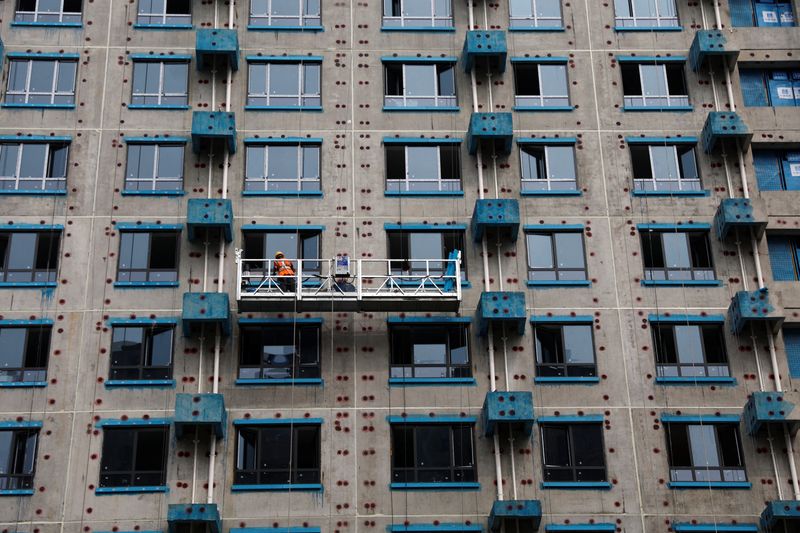
By Vivek Mishra
BENGALURU (Reuters) - China's economy will grow less than previously thought this year and next as a struggling property market dogs what was once the world's growth engine, according to a Reuters poll of economists who said the risks were skewed to further downgrades.
The world's second-largest economy has been struggling after a brief post-COVID recovery, dragged by huge debt due to decades of infrastructure investment and a property downturn, posing risks not only to itself but also to the global economy.
With 70% of household wealth tied up in the ailing property market, coupled with rising youth unemployment, weak consumption demand and the reluctance by depressed private firms to invest, policymakers have been fighting an uphill job in reviving growth.
"The primary culprit is the property sector. This source of growth has now evaporated and won't be coming back," said Julian Evans-Pritchard, head of China economics at Capital Economics in Singapore.
"We have long been more bearish than most...but even we have been surprised by the speed at which growth has declined. The deceleration probably still has further to run."
The Sept. 4-11 Reuters poll of 76 analysts, based in and outside mainland China, predicted the economy would grow 5.0% this year, lower than 5.5% forecast in a July survey. Forecasts ranged between 4.5% and 5.5%.
While nearly all economists lowered their growth outlook for this year and next compared with the previous survey, the magnitude of those cuts was still marginal, leaving room for more downgrades.
Some economists cautioned the government's growth target of around 5% for this year could be missed as the drip-feed of policy stimulus from Beijing would not be enough to stabilise the economy.
While recent data showed signs of improvement in the economy, some economists said more policy support was needed for the ailing property sector. The sector accounts for roughly a quarter of China's economy.
Growth was forecast to slow to 4.5% next year and 4.3% in 2025. After expanding 6.3% last quarter, the economy was expected to grow just 4.2% this quarter, followed by 4.9% in the next, and down to just 3.9% in the first quarter of 2024.
"This slowdown could be just the tip of the iceberg," said Bingnan Ye, senior economist at China Merchants Bank International in Hong Kong, who added the downside risk was "household consumption may improve more slowly than many expect."
"Along with a slowdown in the property sector and exports, we still have U.S.-China trade tensions, and the recent diversification of supply chains beyond China will add to the downside pressure."
A strong majority of economists who answered an additional question said the risks to their 2023 and 2024 GDP growth forecasts were skewed to the downside.
Economists also cut their consumer price inflation forecast to 0.6% for this year and 1.9% for next year, down from the previously expected 1.1% and 2.1% in the July survey.
Despite low inflation, the People's Bank of China was expected to keep its key interest rates on hold this year.
Asked whether there would be an aggressive economic stimulus package from authorities, over three-quarters of economists, 17 of 21, said no.
"Local governments, which are responsible for (about) 85% of expenditures, are heavily indebted. This constrains the ability...to provide meaningful stimulus without further undermining their already fragile finances," said Teeuwe Mevissen, senior macro strategist at Rabobank in the Netherlands.
(For other stories from the Reuters global economic poll:)
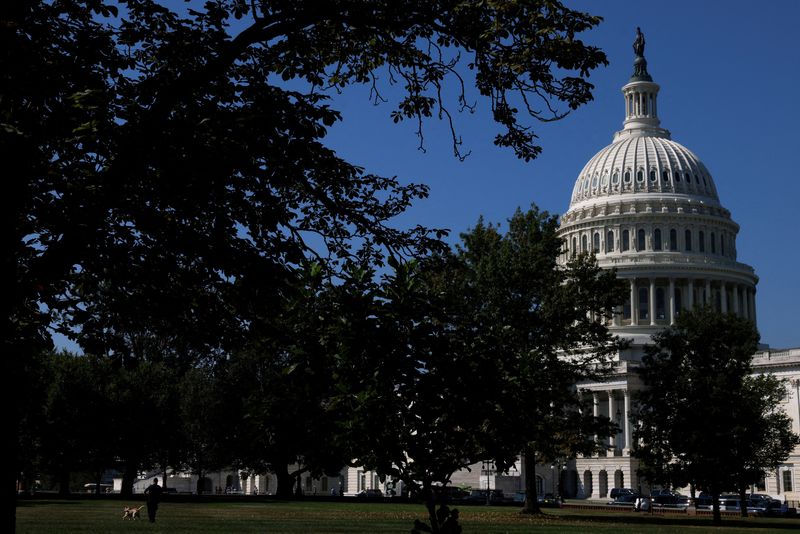
By David Morgan
WASHINGTON (Reuters) - The U.S. House of Representatives returns this week for an expected political brawl over spending cuts and impeachment that could paralyze the Republican-controlled chamber, as Congress struggles to avoid a government shutdown.
The House and the Democratic-controlled Senate are due to be in session for about 12 days before funding expires on Sept. 30, leaving little time to agree on a package of 12 appropriations bills that can pass each chamber and win Democratic President Joe Biden's signature.
The main bone of contention among House Republicans is a demand by roughly three-dozen members of the hardline House Freedom Caucus to cut spending for fiscal 2024 to $1.47 trillion -- about $120 billion less than Biden and Republican House Speaker Kevin McCarthy agreed in May.
The White House and Senate leaders -- including top Republican Mitch McConnell -- have rejected that demand.
That dispute and other hardline demands, including opposition to Ukraine aid and calls for an impeachment inquiry against Biden, could imperil efforts to pass a short-term stopgap, known as a continuing resolution or "CR," which would keep federal agencies afloat while lawmakers debate full-scale appropriations.
"Everything's coming to a head after a long recess," Republican Representative Kelly Armstrong told Reuters, referring to the six-week-long House summer break that ends Tuesday. "We're a pretty diverse caucus, with a five-vote majority. So, threading the needle is something that's really difficult to do."
McCarthy's eight-month-old speakership could be threatened if he seeks Democratic support to avoid a shutdown or fails to move forward with an impeachment inquiry that former President Donald Trump's House allies are seeking despite a lack of votes.
Political brinkmanship over the debt ceiling has already prompted the Fitch rating agency to downgrade U.S. debt to AA+ from its top-notch AAA designation, partly because of repeated down-to-the-wire negotiations that threaten the government's ability to pay its bills.
White House spokesperson Andrew Bates warned that failure to enact $24 billion in supplemental funding for Ukraine and $16 billion for disaster-stricken U.S. communities in states including Hawaii and Florida could put lives at risk, while delaying money to combat the deadly opioid fentanyl.
SOME PREFER SHUTDOWN
Hardline Republicans want offsets for spending on disaster relief and Ukraine aid included in any CR, as well as tighter immigration and border security policies.
"Without these spending cuts, we're a 'no' vote. I say 'we' - me and a good many others," Representative Ralph Norman, a Freedom Caucus member, said in an interview. "I'd rather shut the government down."
That could mean trouble for McCarthy's hopes of restarting action on spending legislation this week with an $886 billion defense appropriations bill.
The House, which Republicans control by a thin 222-212 majority, has passed only one appropriations bill so far.
The Senate plans to move forward on Monday with bipartisan bills. Senators of both parties hope floor action will give them the upper hand in negotiations with the House.
House hardliners vehemently reject a proposal to lump border security and Ukraine aid in a separate measure.
"We're going to have to see some significant win for the American people," Freedom Caucus Chairman Scott Perry told Reuters. "We've been abundantly clear, transparent and precise about how you get votes out of members in the Freedom Caucus."
Hardliners, who forced McCarthy to endure 15 floor votes before he became speaker in January, shut down the House floor in June to protest his spending deal with Biden.
Their demands have irked more centrist Republicans.
With the Senate and White House in Democratic hands, Representative Don Bacon said House Republicans should accept the higher spending level set by the McCarthy-Biden agreement and adopt a relatively clean CR.
"There's no reason to do a shutdown when you already have a bipartisan agreement," Bacon told Reuters. "I know that 20 or 30 people don't like it. But they don't represent the whole House and they don't represent the whole country."
Firebrand Representative Marjorie Taylor Greene vowed not to support funding measures unless the House votes to begin an inquiry on unproven allegations that Biden was involved in his son Hunter's overseas business dealings while vice president. Biden and the White House deny the claims.
Other Republicans reject the idea of tying an impeachment inquiry to the spending debate.
Democrats have dismissed impeachment talk as little more than an effort to distract from Trump's extensive legal woes.
" ... Until you have the votes, it seems kind of silly," Democratic Senator John Fetterman told reporters.
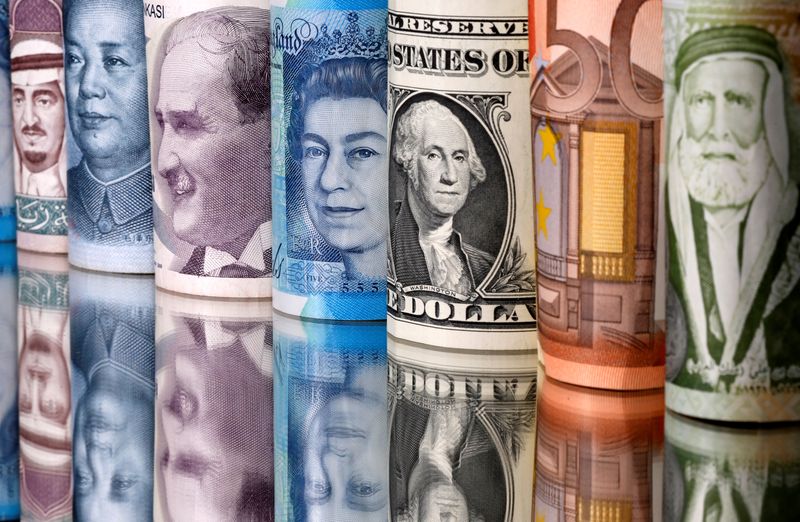
By Jamie McGeever
ORLANDO, Florida (Reuters) -Hedge funds' bearish view on the dollar is evaporating fast and at the current pace of buying they will be outright bullish by the end of the month.
What's more, recent history suggests that when funds go long dollars, they tend to stay long for a while. 'Longer for longer', if you like.
The latest Commodity Futures Trading Commission (CFTC) data shows that funds cut their net short dollar position to $7.17 billion, the smallest bet against the dollar since mid-June and a third of what it was six weeks ago.
It has halved in the last two weeks, and at the current pace the speculative community will be net long of dollars by the end of the month. This shift has coincided with the dollar's rise to a six-month high against a basket of currencies.
A short position is essentially a wager an asset's price will fall, and a long position is a bet it will rise. Hedge funds often take directional bets on currencies, hoping to get on the right side of long-term trends.
This is broadly reflected in CFTC positioning cycles.
From May 2013 - when former Fed chief Ben Bernanke uttered his famous 'taper tantrum' remark - funds went net long dollars for an almost uninterrupted four-year stretch through June 2017, a bullish bet that peaked at a record $51 billion in late 2014.
That was followed by a year being net short dollars, nearly two years of being net long, before swinging back to being net long for over a year. Funds have been net short of dollars since November last year.
This suggests that although the dollar's short-covering rally may not have much juice left in it, the greenback could find a solid source of long-term demand once the speculative community decides to turn outright bullish.
Whether funds do will hinge largely on the interest rate outlook.
There is a growing view that the Federal Reserve's hiking cycle is over, which is intuitively negative for the dollar. But what matters is relative moves - changes in yields relative to current market pricing, and relative to other jurisdictions.
And that is a mixed picture, especially given the latest developments in Japan.
The two-year U.S.-Japanese yield spread remains around 500 basis points in favor of the dollar, around the widest level in over 20 years. A quicker tightening shift from the Bank of Japan than is currently priced in could move that dial rapidly.
CFTC data show that funds are still holding a substantial net short yen position worth around $8.2 bln. Given that funds have been net short the Japanese currency since March 2021, there is potential for the yen to snap sharply higher.
On the other hand, although CFTC funds cut their net long euro position to a seven-month low of 136,000 contracts, that is still a large $18 billion bet that the euro will appreciate.
If the European Central Bank brings its rate-hiking cycle to a premature end - not an unreasonable assumption as growth forecasts are slashed and Germany is seen falling into recession - there is plenty of scope for funds to liquidate their euro longs.
(The opinions expressed here are those of the author, a columnist for Reuters.)
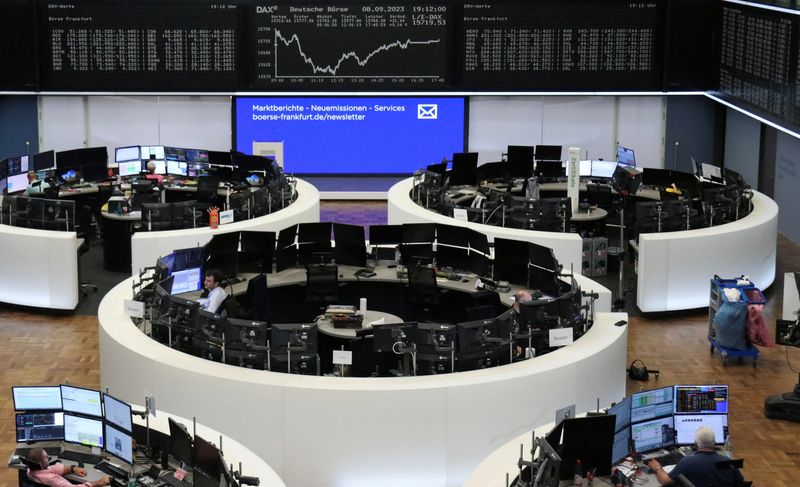
By Amruta Khandekar and Shubham Batra
(Reuters) -European shares hit a one-week high on Monday, buoyed by data indicating signs of stabilisation in the Chinese economy, while traders braced for a busy week with the crucial U.S. inflation print and European Central Bank (ECB) policy meeting in focus.
The pan-European STOXX 600 index gained the most in two weeks, rising 0.6%, after shedding nearly 1% last week amid worries about higher-for-longer U.S. interest rates.
Italian stocks led the gains among European markets, climbing 0.8%, while UK's FTSE 100 rose 0.4%.
Among sectors, the mining index jumped 2.4% as prices of metals rose on prospects of better demand from top consumer China. [MET/L]
Positive inflation data and more stimulus measures from Beijing added to signs that the world's second-largest economy was stabilising.
Investors are now awaiting the U.S. inflation data on Wednesday that would set the direction for global interest rates, while money market participants see a 60% chance that the ECB would keep its interest rates steady on Thursday, according to LSEG data.
"Our economists have nervously held their 3.75% terminal deposit rate call for many months now, and as such they think the ECB will stay on hold," said Deutsche Bank strategists in a note.
"However, even if they don't hike this week, don't expect any sign that the council are confident that this is the last hike. A lot of uncertainty remains over European inflation, whilst GDP has been in near-stagnation since last autumn."
Investors will also closely monitor commentary from ECB officials through the week to cement bets on the central bank's interest rate trajectory.
Among individual stocks, Covestro rose 3.2% after the German chemicals firm on Friday entered into open-ended discussions with suitor Abu Dhabi National Oil Company (ADNOC) over a takeover approach.
Vistry Group led the gains among individual stocks, jumping 13.3%, after the British homebuilder said it would merge its affordable-housing business 'Partnerships' with its Housebuilding operations.
Alfa Laval fell 2.6% after Citi cut the Swedish engineering group's rating to "Neutral" from "Buy", saying it expected a slowdown in order growth to hit earnings.
Ratings agency Fitch will review Germany's long-term credit rating on Friday. The agency currently assigns an 'AAA' rating with stable outlook to Europe's largest economy.
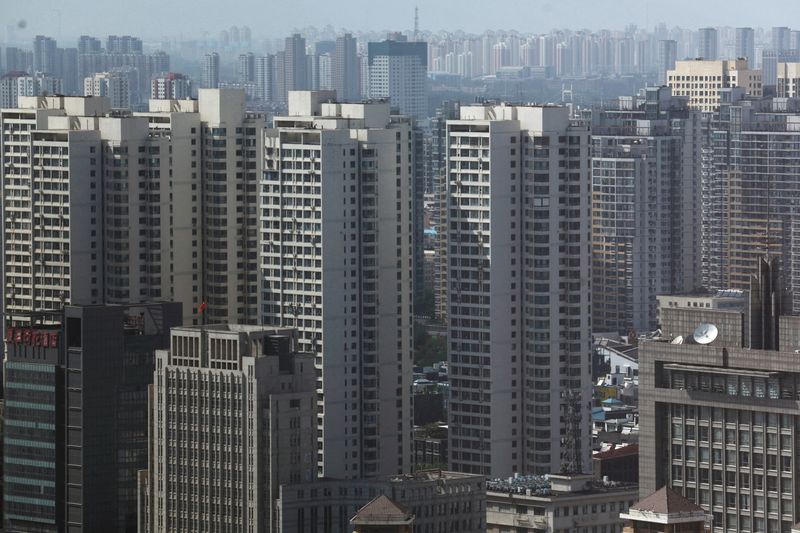
BEIJING (Reuters) - Two major cities in eastern China lifted all curbs on home purchases and selling on Monday, joining several other cities in dropping restrictions to attract buyers and revive a largely frozen property market.
Jinan and Qingdao, two of the largest cities in China's second-most populous province of Shandong, said homes in all areas are allowed to be put on the market, according to a government statement and a local media report.
Qingdao previously limited the number of homes that could be purchased in two districts. Jinan had similar measures.
Last week, three cities - Nanjing in eastern Jiangsu province and Dalian and Shenyang in northeastern Liaoning province - became the first cities to eliminate curbs on home buying.
The moves were part of broader support measures for the sluggish property market, which accounts for a quarter of China's economy. The measures include cuts in interest rates on existing mortgages.
China's property sector has been in a tailspin since 2021 when the government issued strict rules to stop indebted developers from accumulating even more debt.
A sector-wide liquidity crunch followed, slowing down the completion of projects, weighing on home-buyer sentiment and depressing prices.
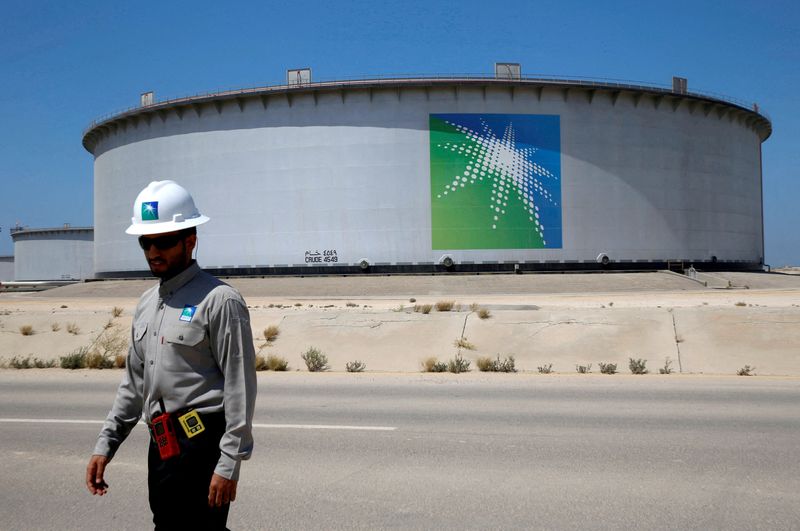
By Yousef Saba and Rachna Uppal
DUBAI (Reuters) -Saudi Arabia faces the risk of an economic contraction this year following its decision to extend crude production cuts, highlighting its still heavy reliance on oil as reforms to diversify are slow moving.
Riyadh says it aims to stabilise the oil market by extending a voluntary oil output cut of 1 million barrels per day until the end of 2023. Its announcement on Tuesday sent oil prices above $90 for the first time this year, but they are below average prices of around $100 a barrel last year in the wake of Russia's invasion of Ukraine.
Declining oil production and revenue this year could see Saudi Arabia's economy shrink for the first time since 2020 at the height of the COVID-19 pandemic, although a hefty dividend from state oil producer Saudi Aramco (TADAWUL:2222) should provide a cushion for public finances.
Cutting oil output for another three months, on top of production cuts earlier in the year, translates into a 9% fall in production in 2023 - the biggest production drop in nearly 15 years for OPEC's de facto leader - said analyst Justin Alexander at Khalij Economics.
Monica Malik, chief economist at Abu Dhabi Commercial Bank, now sees Saudi gross domestic product (GDP) contracting 0.5% this year, revising her forecast from last month of 0.2% growth this year, while Alexander said non-oil growth would need to average about 5% this year to maintain growth.
"This was actually precisely the growth rate in H1, but leading indicators such as the PMI (purchasing managers' index) have pointed to a modest slowdown, so that might be hard to sustain in H2. As a result a small real GDP contraction is looking likely," Alexander, also Gulf analyst at GlobalSource Partners, said.
Last year the Saudi economy grew 8.7% and generated a fiscal surplus of 2.5% of GDP, its first surplus in nine years as oil soared to highs near $124. This year the government has forecast a surplus of 0.4% of GDP, but some economists say even that may be optimistic.
Saudi Aramco, 90% government owned and awash with cash after last year's boom, said last month it would fork out a near $10 billion dividend to shareholders in the third quarter from its free cash flow - the first of several extra payouts on top of its expected more than $150 billion base dividend for 2022 and 2023 combined.
"Even so, we think that the government will run a budget deficit of 1.5% of GDP this year – well below the Budget estimate for a 0.4% of GDP surplus," James Swanston of Capital Economics said in a note.
The Saudi finance ministry did not immediately respond to a request for comment.
The kingdom's deficit stood at 8.2 billion riyals ($2.19 billion) for the first half of this year.
An official from the International Monetary Fund, which had forecast a 1.2% of GDP deficit this year, said on Thursday the budget would be closer to balance as a result of the extra Aramco payout and, unlike a growing number of economists, the IMF also believes the economy will manage slight growth this year.
PIF KEEPS SPENDING
Growth in the non-oil economy remains strong for now.
The Public Investment Fund (PIF), the sovereign wealth fund tasked with driving Saudi Arabia's ambitious Vision 2030 economic blueprint, has spent billions on top global soccer stars, golf, tourism and entertainment, and electric vehicle makers.
"Certainly, we see no signs that the Public Investment Fund's acquisition streak is cooling," RBC Capital Markets said in a note.
PIF did not immediately respond to a request for comment.
Still, reforms and state-led investment have seen the share of the non-oil sector's contribution to GDP rise to 44% of GDP last year, up just 0.7 percentage point from 2016.
"I think the reality has sunk in that the pace of change cannot move as quickly as had been hoped and the economy remains dependent upon hydrocarbons and will do so for some time," said Neil Quilliam, associate fellow at Chatham House in London.
Up to $50 billion worth of fresh Aramco shares could be offered on the Riyadh bourse before the end of the year, according to reports, generating vast funds that could be spent on big projects. The government has transferred 8% of Aramco to PIF and one of its subsidiaries.
PIF's funding comes from capital injections and asset transfers from the government, debt and earnings from investments. However, it reported a loss of $15.6 billion last year, mainly due to its SoftBank (TYO:9984) Vision Fund I investment and a wider market downturn, especially in tech.
"So far PIF investments haven't proven to be as fruitful as had been hoped and neither has the country attracted the FDI (foreign direct investment) it had hoped either... So Aramco is going to be the horse that they keep on beating," Quilliam said.
($1 = 3.7507 riyals)

By Sanjeev Miglani
NEW DELHI (Reuters) - Leaders of the world's 20 big economies ended a summit in the Indian capital on Sunday overcoming deep divisions over the war in Ukraine to produce a consensus document and move forward on issues such overhauling institutions like the World Bank.
They also formally admitted the African Union to the bloc to make the grouping more representative.
SOFTER LANGUAGE ON UKRAINE WAR
G20 nations agreed that states cannot grab territory by force and highlighted the suffering of the people of Ukraine, but avoided direct criticism of Russia for the war. The declaration was seen as an apparent softening from the position that the G20 took last year when it condemned Russia for the war and demanded that it withdraw from Ukraine.
Diplomats said Russia would never have accepted an outright condemnation and that it was still a successful outcome because everyone including Russia committed themselves to not seizing territory by force.
Host India along with Brazil, Indonesia and South Africa, played a key role in avoiding a fracturing of the G20 over the Ukraine conflict, officials said, reflecting the growing power of the Global South developing nations in the group.
AFRICAN UNION INSIDE THE CLUB
The 55-member African Union was formally made permanent member of the G20, on par with the European Union, in order to make the grouping more representative. Until now only South Africa was a member of the G20. The entry of the AU would provide greater voice to the Global South within the G20 where the G7 countries have long played a dominant role.
The move also came after the BRICs, another group dominated by China and Russia, was expanded to include Saudi Arabia and Iran among other nations which was seen as an attempt by Beijing to make it a possible alternate to the G20.
U.S., SAUDI, INDIA JOIN HANDS FOR TRANSPORT CORRIDOR
Leaders of the United States, India and Saudi Arabia among others announced plans to set up rail and ports links between the Middle East and South Asia and eventually to Europe which U.S. President Joe Biden said was a "real big deal."
The Biden administration is seeking to counter China's Belt and Road push on global infrastructure by pitching Washington as an alternative partner and investor for developing countries at the G20 grouping.
But there were no details about financing or a time frame for the project that involved laying down railway lines in the Middle East and then connecting them to India by port.
INCREMENTAL PROGRESS ON CLIMATE CHANGE
The G20 leaders agreed to pursue tripling renewable energy capacity globally by 2030 and accepted the need to phase-down unabated coal power, but stopped short of setting major climate goals.
The group did not provide any plan to amend existing policies and targets in order to achieve the target of ramping of renewables. It also said $4 trillion a year would be needed to pay for a green energy transition but did not lay out any pathway to it.
The deliberations of the G20 were being closely watched ahead of the COP28 U.N climate summit in the United Arab Emirates later this year.
MODI BOOSTS STANDING AS INDIA'S BIG MOMENT ARRIVES
For Indian Prime Minister Narendra Modi, the leadership of the G20 has been a year-long opportunity to showcase India as an influential diplomatic and economic power, and drive investment and trade flows into the world's most populous country.
It has also provided him a platform to boost his standing at home as he seeks a third term in office in elections in the next several months. Modi's image has been on G20 billboards across the capital and in the vast and swanky new conference venue. To his supporters the successful outcome of the summit showed India's big moment had arrived.
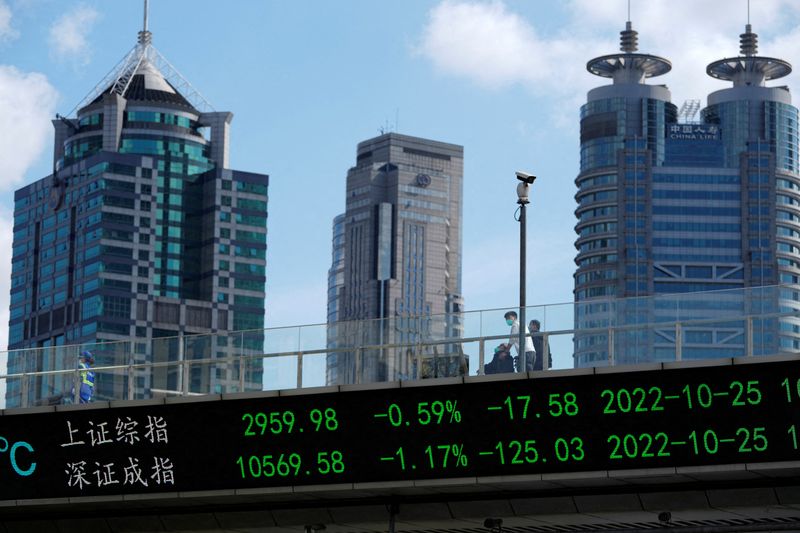
By Jamie McGeever
(Reuters) - A look at the day ahead in Asian markets from Jamie McGeever, financial markets columnist.
Asian markets are set for a nervous open on Monday as worries mount that last week's equity selloff could accelerate, financial conditions continue to tighten, and investors brace for a raft of economic data from China throughout the week.
There seems to be no obvious market impact from the G20 summit in India, and politically-influenced trading will likely be dominated by U.S.-China tensions. Last week Apple (NASDAQ:AAPL)'s 6% slide wiped $180 billion off its market cap on news that Beijing had banned government employees from using iPhones at work.
Broader market sentiment is fragile. The Nasdaq shed 2% last week, and the S&P 500, MSCI World and MSCI Asia ex-Japan Index all fell more than 1%.
Tightening financial conditions from high bond yields and a strong dollar, and unease about the looming lag effects of the Fed's rate hikes are coming together in what has been historically a notoriously volatile month for stocks.
According to Goldman Sachs's real-time indexes, financial conditions in China, emerging markets and globally are now the tightest since last November.
The dollar is at a six-month high, Asian currencies are feeling the heat, and traders are on intervention alert - India's rupee posted a record closing low on Thursday and the Japanese yen, Philippine peso and Thai Baht are at their lowest levels this year.
Currencies may also get direction from a sprinkling of key economic indicators across the region this week - Indian trade and inflation, Australian unemployment, Indonesia retail sales, and Japanese industrial production and machinery orders.
The economic data spotlight this week will shine on China. Beijing often concentrates the release of key indicators into short bursts - often referred to as the 'Chinese data dump' - but this one is particularly heavy.
Money supply, loan growth, social financing (a broad measure of credit and liquidity in the economy), retail sales, industrial production, unemployment, house prices and fixed asset investment are all due for release by September 15.
That follows producer and consumer price inflation figures on Saturday that suggest disinflationary pressures are sticky. Annual PPI was negative for the 11th month in a row, and annual CPI rose only 0.1%, undershooting forecasts of a 0.2% increase.
The state of China's economy will be much clearer by the end of the week, as will the scale of the task facing authorities to provide the necessary monetary and fiscal stimulus to keep Beijing's goal of 5% GDP growth this year in sight.
But complicating this is the yuan, which is at a 16-year low. Further policy easing will put it under even heavier downward pressure, risking a spiral of FX depreciation, asset market weakness and capital flight.
Here are key developments that could provide more direction to markets on Monday:
- Malaysia industrial production (July)
- Japan money supply (August)
- U.S. 3-year note auction
(By Jamie McGeever; Editing by Diane Craft)
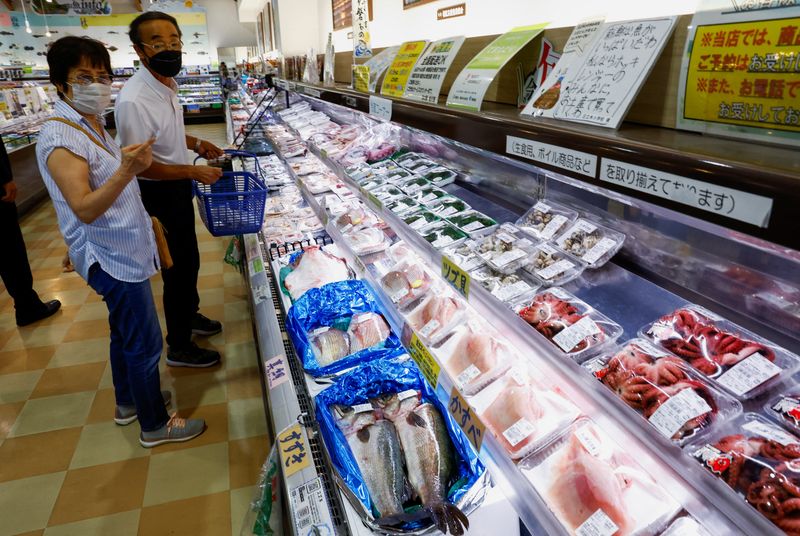
By Leika Kihara and Yoshifumi Takemoto
TOKYO (Reuters) -Japan's economy grew less than initially estimated in the second quarter and wages slumped in July, casting doubt over central bank projections that solid domestic demand will keep the country on course for a recovery.
Capital expenditure and private consumption both fell in the April-June period, revised gross domestic product (GDP) data showed on Friday, underscoring the fragile state of Japan's economy, which is already facing headwinds from weakening Chinese and U.S. growth.
Real wages adjusted for inflation fell in July for a 16th straight month in a sign households continued to feel the pinch from rising prices, separate data showed, boding ill for consumption.
"Weak exports to China may be making Japanese manufacturers cautious about investing. The hope is that service-sector firms will pick up the slack, though sluggish consumption could discourage them to spend money, too," said Takeshi Minami, chief economist at Norinchukin Research Institute.
Japan's economy grew an annualised 4.8% in April-June, the revised data showed, down from a preliminary estimate of 6.0% growth and below market forecasts for a revised 5.5% expansion.
The main factor behind the downgrade was a 1.0% drop in capital expenditure, compared with a preliminary flat reading, casting doubt on the BOJ's view that robust corporate spending will underpin Japan's post-pandemic economy. The revised decline was bigger than a median market forecast for a 0.7% fall.
Private consumption, which makes up more than half of the economy, fell 0.6% quarter-on-quarter in the April-June period, compared with a preliminary 0.5% decline.
Exports remained solid in April-June with net external demand contributing 1.8% points to GDP growth, unchanged from the preliminary reading.
But shipments to China slumped 13.4% in July to mark the 8th straight month of falls. Overall exports slid 5.0% year-on-year in the first half of August after a 0.3% decline in July, suggesting the global slowdown was taking a toll on the economy.
As weak domestic demand led to declines in imports, Japan's current account surplus logged a record amount for the month of July, separate data released on Friday showed.
"I won't be surprised if Japan suffers two straight quarters of contraction during the rest of this year," said Minami of Norinchukin. "The chance of an early end to ultra-loose monetary policy is diminishing."
Japan's economy has seen a delayed recovery from the COVID-19 pandemic this year, as rising living costs faltering global demand cloud the outlook.
Given such uncertainties, Bank of Japan policymakers have stressed their resolve to keep monetary policy ultra-loose until the recent cost-driven inflation turns into price rises driven by domestic demand and higher wage growth.
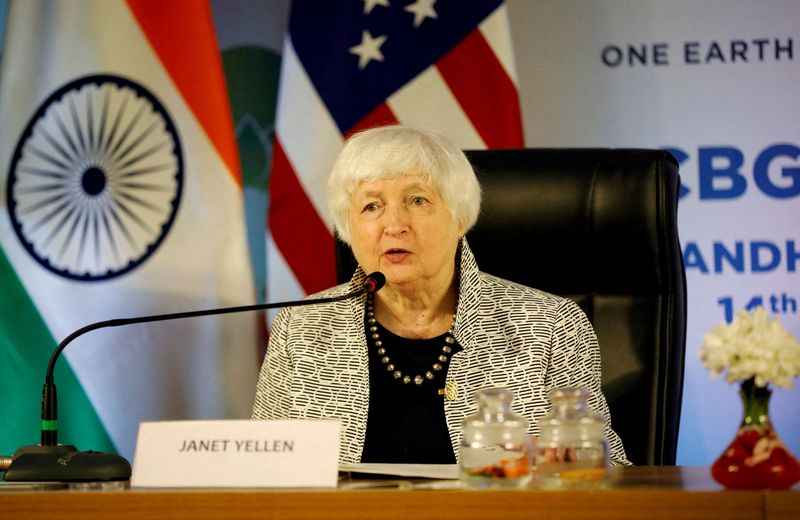
By Nikunj Ohri and David Lawder
NEW DELHI (Reuters) -U.S. Treasury Secretary Janet Yellen said on Friday the United States was willing to work with India to help craft a communique at the end of the Group of 20 Summit in New Delhi over the weekend, but it would be a challenge.
"So I understand that this is challenging to craft such language, but I know the negotiators are discussing it, and working hard to do so and we stand ready certainly to work with India to try to craft a communique that successfully addresses this concern," Yellen told reporters at a briefing.
Analysts say deeper and more entrenched divisions over Russia's war in Ukraine risk derailing progress on issues such as food security, debt distress and global cooperation on climate change when the world's most powerful nations meet this weekend in New Delhi.
In her prepared comments, Yellen said she will work to build support to increase lending resources for the International Monetary Fund and the World Bank to help member countries deal with multiple global challenges, including new IMF quota resources.
She will seek to build G20 support for an "equi-proportional" increase in IMF quota funds paid-in by member countries, which would increase IMF lending resources, but not immediately change its shareholding structure.
At the briefing, Yellen said there was significant progress made on international debt relief efforts.
"International debt and providing relief to countries that are overindebted partly because of the impact of Russia’s war against Ukraine, but also the high interest rate environment, I believe we're beginning to make significant progress there. So I do see the G20 as a very effective forum," she said.
Yellen also said the United States has asked the U.S. Congress for permission to lend $21 billion to IMF trust funds, including one for the poorest countries, which "desperately needs more resources."
She highlighted progress on efforts over the past year by the World Bank and other multilateral development banks to vastly expand lending resources and help tackle climate change, pandemics and other global crises.
Near-term balance sheet changes under consideration could unlock an additional $200 billion over the next decade, she said.
More resources could come from medium-term steps recommended by a G20 capital adequacy review, including the use of callable capital that is pledged, but not paid-in, to back lending.
"Those are crucial additional resources for reducing poverty, advancing global health security and combating climate change," Yellen said.
The U.S. Treasury chief also said she will work to strengthen international support for Ukraine at the G20 gathering, saying it was "critical that we continue to provide timely economic assistance" through such measures as the IMF's $15.5 billion Ukraine loan program and the European Union's proposed 50 billion-euro support package through 2027.
"Even without Russia's active participation and the tensions the war has created, I still see that G20 is highly effective," Yellen said.

